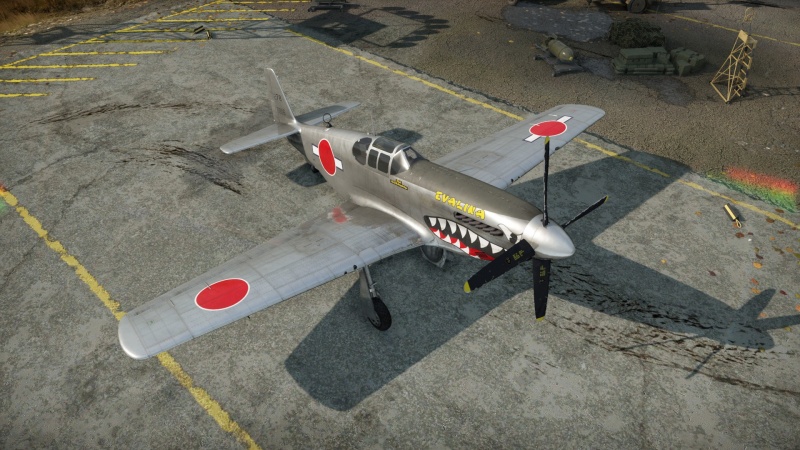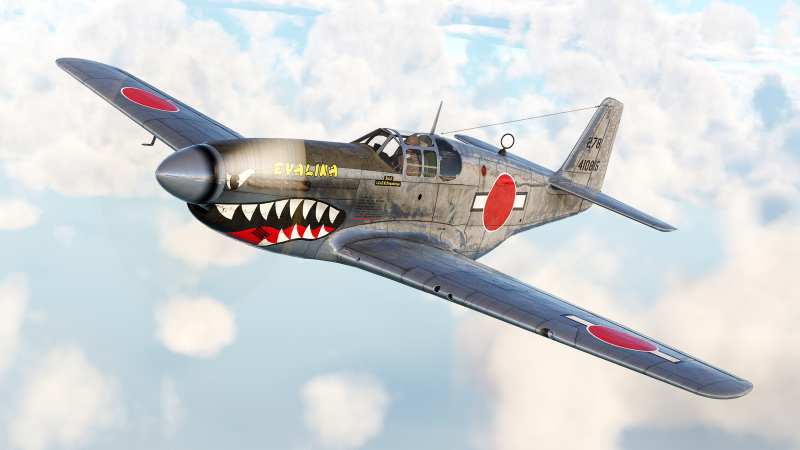P-51C-11-NT (Japan)
| This page is about the Japanese fighter P-51C-11-NT (Japan). For other versions, see P-51 (Family). |
Contents
Description
The ▅P-51C-11-NT is a premium rank III Japanese fighter with a battle rating of 3.7 (AB/RB) and 4.0 (SB). It was introduced in Update "Red Skies".
She's nicknamed "Evalina" by her pilot 1.Lt. Oliver E. Strawbridge, which is painted on the engine. This plane got captured on January 16, 1945 by the Japanese rather undamaged after a crash landing and hastily seized by Japanese personnel and painted Hinomaru's over the original scheme. She would be thoroughly be evaluated by Japan till the end of the War.
General info
Flight performance
Unlike its Rank II predecessors, the P-51 and A-36, this plane performs well not only at low altitudes but also above 3,000 metres because of the new Merlin engine and two-stage supercharger instead of one-stage in the Allison powered models. Level speed is exceptionally good at all altitudes compared to the opposition at similar battle ratings. In Realistic Battles, it can reach 610 km/h at sea level and 705 km/h at 7,300 metres of altitude. Acceleration is also above average in level flight. The climb rate is good, especially when compared to the other American planes, and is noticeably better than the P-51D-5 and P-51D-20. At low altitude, it is slightly above 20 m/s and the plane can reach 6,000 m alt in about 7 minutes. Diving performance is great as usual, its elevator and other control surfaces do not lock up even at 700-800 km/h IAS and can pull 9G at that speed. Medium and high-speed manoeuvrability is good enough to keep up with the Bf 109 G and similar fighters for a while, and the sustained turn rate has been improved over previous Mustangs. Horizontal energy retention is very good, vertical energy retention is good, but manoeuvring energy retention is somewhat below average (but only in RB because of how the instructor controls the plane). Low speed manoeuvrability is still mediocre. The main issue is its rudder, which can lock up above 300 km/h IAS, albeit not to the extent of the P-51D models since the "razorback" fuselage provides better directional stability. The roll rate is not exceptional, veering into poor territory at low speeds.
If using Manual Engine Controls, it is worth mentioning that the Meredith effect is modelled on Mustangs. The cooling system is designed to generate a slight thrust that partially compensates for the aerodynamic drag caused by the radiators. This means that opening up the radiators even to high percentages only causes small effects on energy retention and top speed while keeping the engine nice and cool on WEP settings.
When flying with full realistic controls, the plane requires some trimming, positive for the elevator (+ 5-7) and rudder or ailerons to the right (but only below 600 km/h IAS) if you want to keep the plane straight in the level flight, when turning the plane tends to roll to the right side. Stall characteristics are very good, with the fuel set to 30 minutes it stalls out only when the elevator deflection reaches 90%. It does have a high stalling speed, however, at 175 km/h without flaps and 155 km/h with flaps.
| Characteristics | Max Speed (km/h at 7,300 m) |
Max altitude (metres) |
Turn time (seconds) |
Rate of climb (metres/second) |
Take-off run (metres) | |||
|---|---|---|---|---|---|---|---|---|
| AB | RB | AB | RB | AB | RB | |||
| Stock | 685 | 666 | 12800 | 22.0 | 22.6 | 12.9 | 12.9 | 300 |
| Upgraded | 734 | 708 | 20.5 | 21.0 | 20.2 | 16.2 | ||
Details
| Features | ||||
|---|---|---|---|---|
| Combat flaps | Take-off flaps | Landing flaps | Air brakes | Arrestor gear |
| ✓ | ✓ | ✓ | X | X |
| Limits | ||||||
|---|---|---|---|---|---|---|
| Wings (km/h) | Gear (km/h) | Flaps (km/h) | Max Static G | |||
| Combat | Take-off | Landing | + | - | ||
| 853 | 287 | 675 | 675 | 275 | ~11 | ~5 |
| Optimal velocities (km/h) | |||
|---|---|---|---|
| Ailerons | Rudder | Elevators | Radiator |
| < 500 | < 300 | < 550 | > 400 |
Survivability and armour
The survivability is similar to most other prop fighters. The engine is located in the nose, and the fuel tanks are located behind the pilot's seat and in the wing roots. There is significant armour protection for the pilot, but the pilot is still vulnerable from the top, bottom, and sides. The fuel tanks are also vulnerable, as is the cooling system.
- 38 mm Bulletproof glass - Windshield
- 11.11 mm Steel - Behind pilot's seat
- 6.35 mm Steel - Behind engine, in front of oil cooling system and pilot
- 6.35 mm Steel - In front of upper engine
- Self-sealing fuel tanks
Modifications and economy
Armaments
Offensive armament
The P-51C-11-NT (Japan) is armed with:
- 4 x 12.7 mm M2 Browning machine guns, wing-mounted (280 rpg outer + 350 rpg inner = 1,260 total)
While the Evalina only has 4 x 12.7 mm's, she does get late-war belts for ammo choice, giving her relatively more consistency and firepower over the American P-51C-10 with early war belts.
Since the guns are mounted in the wings, gun convergence should be considered. Anywhere between 400-600 metres should work well, but note that more distant convergence settings will make close-range shooting more difficult, especially considering the low volume of fire.
Usage in battles
The P-51C-11 has outstanding performance compared to other planes that can meet in the same bracket (Enduring Confrontation 3, BR 3.7-4.7), level speed is higher at all altitudes than anything that it can face, so it can easily escape from anything when it finds itself in a trouble, climb rate is also very good and allows it to quickly get to the 3,000-5,000 m alt. This plane like all other Mustangs does not overheat when the radiator is set to 90-100%, it also does not slow down the plane, so it can always cruise with enabled WEP which is not limited, always engage other planes with humongous speed advantage and make use of very good mid and high-speed manoeuvrability. Sustained climb rate is worse than that of the Bf 109 F-4 or G-2 by 2-4 m/s, escaping from them by climbing away should be avoided, but still allows the plane to get pretty quick to 3,000-5,000 m alt, also the zoom climb is very good.
One issue that the plane has is quite disappointing armament, sometimes it takes some time to shoot down the enemy fighters and it is even worse against bombers and attackers with higher durability, but attacking with a speed advantage and surprising the enemy should solve it.
The other issue is unsatisfactory turn rate at low speed, engaging other fighters in dogfight should be avoided (instantaneous turn rate is actually good when the plane has lots of energy to spare), especially the Bf 109 F-4, G.55 or Yaks and anything that can turn better than them, the speed advantage should be used instead to beat them.
Because of these points, the preferable tactics for this plane should be Boom and Zoom and other manoeuvres that do not purely depend on turn rate and more on the plane's speed. Dogfighting can work to some extent and against some planes like the Fw 190 A (which does not really stand a chance against the razorback Mustang) but while doing that the player will be forced to sacrifice speed advantage and make the plane vulnerable to attacks from slower planes with far better turn rates.
Manual Engine Control
| MEC elements | ||||||
|---|---|---|---|---|---|---|
| Mixer | Pitch | Radiator | Supercharger | Turbocharger | ||
| Oil | Water | Type | ||||
| Not controllable | Controllable Not auto controlled |
Controllable Auto control available |
Controllable Auto control available |
Separate | Not controllable 2 gears |
Not controllable |
Pros and cons
Pros:
- Outstanding Boom & Zoom capability
- Great performance at altitude
- Very fast at all altitudes, especially in a shallow dive
- Very agile at high speeds due to laminar flow wings
- Decent cockpit visibility
- Large fuel capacity (1 hour 45 minutes maximum flight time)
- Fantastic top speed and acceleration
- Very good sustained climb rate
Cons:
- Only four 12.7 mm M2 Browning machine guns with mid-war belts which don't do much damage
- High stall speed and mediocre low speed manoeuvrability
- No suspended ordanance
- Not very durable
- Roll rate, while not terrible, is not sufficient enough to shake enemy planes off or force overshoots
History
Describe the history of the creation and combat usage of the aircraft in more detail than in the introduction. If the historical reference turns out to be too long, take it to a separate article, taking a link to the article about the vehicle and adding a block "/History" (example: https://wiki.warthunder.com/(Vehicle-name)/History) and add a link to it here using the main template. Be sure to reference text and sources by using <ref></ref>, as well as adding them at the end of the article with <references />. This section may also include the vehicle's dev blog entry (if applicable) and the in-game encyclopedia description (under === In-game description ===, also if applicable).
Media
Excellent additions to the article would be video guides, screenshots from the game, and photos.
See also
Other variants in-game
External links
| Japan fighters | |
|---|---|
| Navy | |
| Carrier-based fighter | |
| A5M | A5M4 · Hagiri's A5M4 |
| A6M | A6M2 mod. 11 · A6M2 · A6M3 · A6M3 mod. 22 · A6M3 mod. 22Ko · A6M5 · A6M5 Ko · A6M5 otsu · A6M5 Hei · A6M6c |
| A7He | A7He1* |
| A7M | A7M1 (NK9H) · A7M2 |
| Land-based Fighter | |
| J2M | J2M2 · J2M3 · J2M4 Kai · J2M5 · J2M5 (30 mm) |
| J6K | J6K1 |
| J7W | J7W1 |
| N1K-J | N1K1-Ja · N1K2-J · N1K2-Ja |
| Fighter seaplane | |
| N1K | N1K1 |
| A6M-N | A6M2-N |
| Army | |
| Ki-10 | Ki-10-I · Ki-10-I C · Ki-10-II · Ki-10-II C |
| Ki-27 | Ki-27 otsu · Ki-27 otsu Tachiarai |
| Ki-43 | Ki-43-I · Ki-43-II · Ki-43-III otsu |
| Ki-44 | Ki-44-I · Ki-44-I 34 · Ki-44-II otsu · Ki-44-II hei |
| Ki-61 | Ki-61-I ko · Ki-61-I otsu · Ki-61-I hei · Tada's Ki-61-I hei · Ki-61-I tei · Ki-61-II Otsu Kai |
| Ki-84 | Ki-84 ko · Ki-84 otsu · Ki-84 hei |
| Ki-87 | Ki-87 |
| Ki-94 | Ki-94-II |
| Ki-100 | Ki-100 · Ki-100-II |
| Other countries | ▅F4U-1A · ▅P-51C-11-NT · ▅Bf 109 E-7 · ▅Fw 190 A-5 |
| *Imported designation of the He 112 (A6M was in development - A7M would take A7 designation after the cancelation of the A7He) | |
| Japan premium aircraft | |
|---|---|
| Fighters | Hagiri's A5M4 · A7He1 · Ki-27 otsu Tachiarai |
| Ki-44-II otsu · ▅Bf 109 E-7 · ▅F4U-1A · Ki-100-II · Ki-44-I 34 | |
| ▅Fw 190 A-5 · A7M1 (NK9H) · Tada's Ki-61-I hei · ▅P-51C-11-NT | |
| J2M4 Kai · A6M5 Ko · A6M6c · J2M5 · Ki-87 · J6K1 | |
| Twin-engine fighters | Ki-96 |
| Jet fighters | F-86F-40 JASDF▅ · T-2 Early · F-4EJ ADTW |
| Strike aircraft | ▄AV-8S |
| Bombers | Ki-21-I hei · Ki-48-II otsu · H8K3 · B7A2 (Homare 23) · ▅B-17E |






